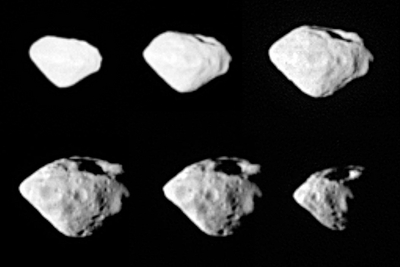The European Space Agency's Rosetta spacecraft took the closest images to date of the asteroid that until now appeared to be a dot from Earth, and also has an interesting surface trajectory

During the weekend, the first images from the OSIRIS camera and the VIRTIS infrared spectrometer on board the Rosetta spacecraft were released, and the results, say the European Space Agency, are spectacular.
"Steins looks like a diamond in the sky" says Au Keller, the principal investigator of the OSIRIS camera at the Max Planck Institute in Lindau. The picture shows several small and two large craters, one of which is 2 kilometers in diameter, indicating that the asteroid must be ancient. The images are 50-60 pixels in diameter, enough to characterize the shape of the terrain route and other features.
Rita Schultz, Rosetta's Chief Scientist says: "In the image you can see a series of impact craters that must have been created by successive impacts as the asteroid rotated around its axis. It is possible that this is the impact of a stream of meteorites or fragments from another small celestial body that shattered. The chain itself includes about 7 craters. To determine the age of the asteroid, the scientists began to count the number of craters on the surface of the asteroids, the more craters there are, the older the asteroid. So far 23 craters have been discovered. From the images, the scientists will try to understand why the asteroid is unusually bright, and how small the regolith grains are on its surface. This will tell them more about the way the asteroid was formed.
Gerald Schum, Rosetta mission manager at the European Space Agency says: "Steins looks like a typical asteroid, but it's fascinating to know how much we can learn just from the pictures. Of course, these are only the scientific titles. We still have a lot of promising science ahead of us. I'm already waiting for the meeting with the next diamond in the sky - the much larger asteroid Lutetia."
And not only the scientists are happy, the engineers are too - the Wide Angle Camera (WAC) inside Osiris worked great during the approach to Steins. The Osiris team is also looking forward to receiving the images from the Narrow Field Camera (NAC) and seeing if they will also be of similar resolution. This will make it possible to add color details and add to the knowledge of the composition of the soil.
The team of scientists emphasizes that the narrow-angle camera seems to have switched to a safe mode a few minutes before approaching the smallest distance from the asteroid, but turned back on after a few hours. The system is programmed to go into safe mode when a crash occurs that could endanger the device. The team will concentrate on investigating the causes of the anomaly as soon as the scientific information can be analyzed.
After the Rosetta data analysis is complete, Steins will be one of the best-characterized asteroids to date.

One response
Pretty.